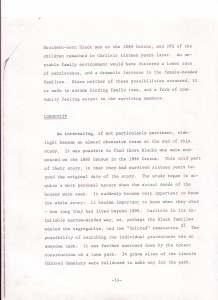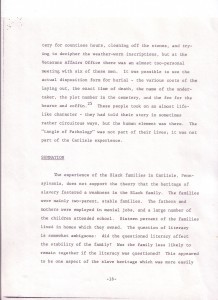In my first manuscript research trip to the Dickinson Archives, I found four different texts that I hoped would provide secondary source or background information on Lincoln Cemetery or any of the soldier buried there. I found them by searching for many of the same terms I used to find non-archive secondary source, but here I also researched into Susan Cavenagh to explore what other texts she had written. I used the following four archive texts:
- Cavenagh, Susan. Blacks in Carlisle, 1870-1880. Dickinsoniana Books, 1978. (Honors History 1978 C379b)
- Cavenagh, Susan Savage. The Black Experience in Carlisle, 1880. Dickinsoniana Books, 1976. (Essays History 1976 C379b)
- Valanos, Vicky. Social Mobility of Blacks in Carlisle. Dickinsoniana Books, 1981. (Essays History 1981 V136s)
- Lindbuchler, Ryan L. Gone But Not Forgotten: Civil War Veterans of Northeastern Pennsylvania. Luzerne County Historical Society, 2001.
Lindbuchler’s book lists dozens of Civil War veteran cemeteries and expresses a mission to tell the stories of soldiers so they are not forgotten. Unfortunately, black veterans must be the ones that are gone and forgotten, because Lindbuchler’s book has no mention of African American veterans or cemeteries.
Susan Cavenagh’s “Blacks in Carlisle, 1870-1880,” is actually a great tool for historians of this time period. She analyzed how other historians reconstructed African American time periods by using court records, census data, newspapers, tax records, birth/death certificates and similar sources. Then she attempted to model this in a quantitative way. While she unfortunately does not annex any of the records she found other than the census, her census data is staggering. She took all of the 1870 and 1880 data and transcribed the writing for all African Americans in Carlisle. The majority of her work is quantitative SPSS outputs, which compares formerly southern blacks in Carlisle to northern blacks, and attempts to figure out who was better off.
Vicky Valanos’s “Social Mobility of Blacks in Carlisle” is an essay that looked at how Cavenagh analyzed the 1870 and 1880 Census, and tried to do a small analysis of this for 1900. For both of these works, I am glad I read them, but I know that I can find census records on ancestry. Cavenagh does make them much more legible. I also used Cavenagh’s suggestion in her paper to look at the Carlisle Herald and the Carlisle Valley Sentinel for more information.
Lastly, I looked at Susan Cavenagh’s “The Black Experience in Carlisle 1880.” I knew she had  recorded the gravestone names at Lincoln Cemetery, but her honors thesis had not included mention of this at all. I hoped she hadn’t just left it out. Luckily I found these three pages at the end of her essay on African Americans in 1880.
recorded the gravestone names at Lincoln Cemetery, but her honors thesis had not included mention of this at all. I hoped she hadn’t just left it out. Luckily I found these three pages at the end of her essay on African Americans in 1880.
These three pages were great for my research and explained why Cavenagh was connected to the gravestone research. It also explained how she had researched in the Cumberland County Courthouse, the existence of maps, and the existence of burial records.
One of the big mysteries of her research was a missing appendix at the end of her essay. After her first  appendix and bibliography it said on the last page, “Appendix #2. Maps Showing Geographic Distribution of Sample, Selected Gravestones.” I sat with the archivists theorizing about where the maps could be, whether they could be in another collection or whether they were lost for good. I would later discover than these were just the same maps I had found at CCHS, but not until I had talked with about four archivists. Malinda Triller emailed CCHS society for me while I contacted the Cumberland Country Courthouse archivist. Both were extremely helpful.
appendix and bibliography it said on the last page, “Appendix #2. Maps Showing Geographic Distribution of Sample, Selected Gravestones.” I sat with the archivists theorizing about where the maps could be, whether they could be in another collection or whether they were lost for good. I would later discover than these were just the same maps I had found at CCHS, but not until I had talked with about four archivists. Malinda Triller emailed CCHS society for me while I contacted the Cumberland Country Courthouse archivist. Both were extremely helpful.
The manuscript search gave me a little more background to my story and let me know how far Cavenagh had researched into it as well. This allowed me to see what had been done and what needed to be expanded upon.

